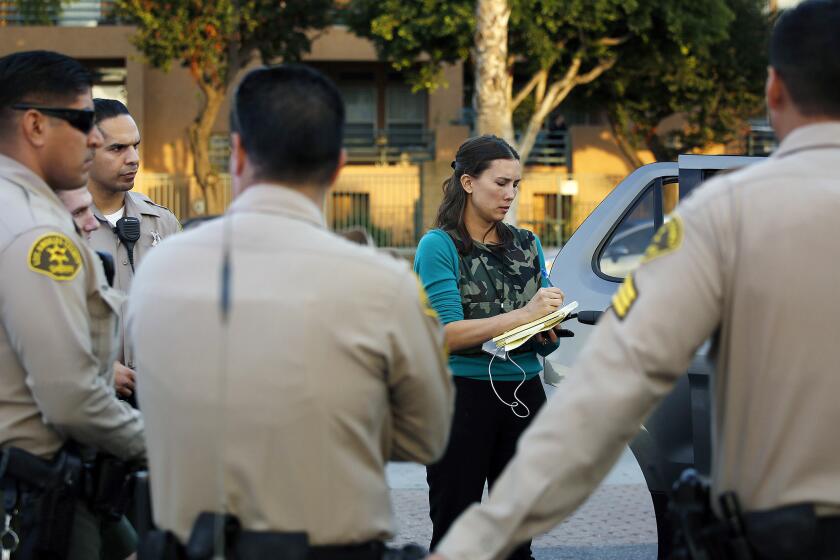Border Agents Take on Role of Lifesavers
- Share via
ANZA-BORREGO DESERT, Calif. — Getting arrested right off the bat might have been a stroke of good fortune for Modesto Zarate and his four traveling companions.
On a day when the temperature in this bleak, sun-seared corner of the Imperial County desert would climb to 115 degrees, the five young men from the Mexican state of Michoacan were woefully ill-prepared for the trek they had begun. The previous night’s walk, which included sneaking across the border into the United States, had left them with just a half-gallon of water to share.
Now facing daylight and a 25-mile hike to reach the next highway--and drinking water--the group rested in a dusty creek bed as three U.S. Border Patrol agents, members of a special desert rescue team, rolled up and brought the journey to an early end. The immigrants, toting duffels stocked with canned sardines and tortillas, said they had been aiming for Fresno and farm jobs. Asked how they planned to get there, one of the men gestured vaguely toward distant mountains to the north.
Unprepared, poorly informed, desperate for work--such are many of the migrants who cross through the desert here without papers. They are the focus of the special Border Patrol team, based in El Centro, that is operating for a second summer. The job of the four-agent detail is not to nab undocumented migrants slipping across the border, but to scour daily a broad swath 15 miles to the north in search of those who become lost or stranded in some of the most unforgiving terrain along the 2,000-mile U.S.-Mexico border.
The rescue team, equipped with all-terrain vehicles, a dune buggy and medical gear, is part of the Border Patrol’s response nationwide to a rising number of immigrants who die while trying to cross illegally. The agency’s parent, the U.S. Immigration and Naturalization Service, is accused by critics of forcing undocumented border crossers into dangerous zones by clamping down in populated areas, such as San Diego.
In answer to the border fatalities, totaling 307 nationwide from October through Aug. 18, the INS has moved to improve agent training, shifted patrol airplanes to the Arizona desert from the Canadian border and produced Spanish-language public service warnings for broadcast in Mexico about the perils of crossing the desert. Heat exposure is now ahead of drowning as the leading cause of border deaths.
“A lot of people are from [Mexico’s] interior and they don’t know what they’re getting into,” team supervisor Tracy Warner said during a recent shift patrolling the desert.
Zarate, 25, accompanied by two brothers, a cousin and another man, said he had seen televised warnings, but felt the risk was outweighed by the need for work. “We see [the warnings], but you don’t think anything bad will happen to you. So you go,” he said, shortly before the five men boarded a Border Patrol truck for a ride to the station and transfer back across the border at Mexicali.
Since October, the start of the fiscal year, at least 19 people have perished from heat-related causes in Imperial County, three more heat deaths than at the same time last year. The team’s vast patrol area of about 1,000 square miles--bounded on the south by Interstate 8 and on the north by California 78 and sweeping in the chalky canyons of Anza-Borrego Desert State Park--is stark, stunning to behold and bristling with danger.
On top of merciless heat, an untold number of unexploded bombs lie amid the scrub on a military practice range about 30 miles northwest of El Centro. Team members notify military authorities when they track footprints or tire marks onto the range.
“We’re just making sure that if any go through here, that they make it through,” Warner said, guiding a Ford Expedition along a sandy track that skirts the range. The agents arrest the migrants once they are out of the bombing zone.
Change Reflects New Complexities
This may seem an incongruous twin role--captor and rescuer at once--but Border Patrol agents say it reflects a complex new reality in the once-quiet back country. Migrants have hung socks and T-shirts on bushes to signal for help. A man left for three days without water along a road in the Anza-Borrego park was praying when he was located, Warner said.
Viewing their role as that of potential lifesaver, agents on the detail find it frustrating when migrants run away. One agent who came upon a group along an isolated stretch near Ocotillo expressed exasperation after several migrants fled. “They may get away from us, but where are they going to go out there?”
Desert fatalities have prompted widespread criticism of the Border Patrol’s heightened enforcement in border cities where illegal crossings were rampant. By steering undocumented immigrants into remote corridors, human rights advocates say, the U.S. government has created the conditions that now call for rescue measures.
“It’s a total contradiction,” said Roberto Martinez, who heads a border project for the American Friends Service Committee in San Diego. “It’s like the Department of Forestry starting a fire in the Cleveland National Forest and putting it out and patting themselves on the back as heroes.”
For their part, Border Patrol officials credit the team with rescuing more than 30 migrants in distress and arresting about 1,870 others since October. In recent weeks, the desert agents found 24 people stranded without food or water after a smuggling van broke down miles from the nearest road. Abandoned in the same area is another smuggling van that broke down two years ago. The bodies of eight migrants were later found a few miles away.
Lining one side of the bombing range are clusters of plastic water jugs, each marked with a blue flag, that provide an emergency supply for wayward immigrants. Volunteers including John Hunter, a San Diego businessman and brother of U.S. Rep. Duncan Hunter (R-El Cajon), have set out 100 of the water stations in two areas near the border. “You have a body here and a body there. It’s a scattered thing but they add up astronomically,” said John Hunter. “We want it to stop.”
Rep. Hunter, an ardent advocate of tighter border controls, has lent his support to the project, begun two months ago. But migrants have told agents they steer clear of the stations, fearing a trap by the U.S. government.
Not far away, beneath a salt cedar tree, lies the refuse--jugs of brownish water and a discarded bean can--left by 14 people Warner recently found. All were fine except for a woman who was sick to her stomach--perhaps from drinking water from irrigation canals several miles away. Eleven members of the group were caught near the same spot a few days later after reentering the country.
With so much attention on the issue, stakes are high for Warner and his team members, who are assigned for three-month stints from April until the weather cools in the fall.
Unlike counterparts who work directly on the border, the desert patrol agents cannot easily throw up their hands when a trail of footprints grows faint. On a recent day, the agents spent the better part of an hour zigzagging in their vehicles among the creosote bushes to track the footprints of a group of four or five people. The agents finally determined that the tracks belonged to a group they arrested days earlier. “We’re going to keep after them to make sure we know what happened to them,” Warner said.
Soon after, Warner captured 21 people off a rural highway outside the farming community of Seeley. The migrants, who were hiding in bushes, carried little to drink and looked wilted in the severe midday heat. A young man in the group had given away the location when he dashed to the road. Warner figured the youth was one of the group’s guides.
Now caught, the young man, who gave his name as Manuel Ortega Dominguez and his age as 19, voiced a concern more immediate than his failed venture.
He emerged from hiding, brushed the dust off his clothes and turned to a visitor. “Do you have any water?” he asked.
More to Read
Sign up for Essential California
The most important California stories and recommendations in your inbox every morning.
You may occasionally receive promotional content from the Los Angeles Times.













